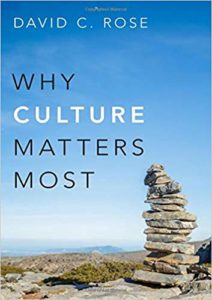Culture, Institutions, and Folkways
By Arnold Kling


- it is indeed culture—not genes, geography, institutions, policies, or leadership—that ultimately determines the differential success of societies.
- —David C. Rose, Why Culture Matters Most,1 page 1
Some economists, including David C. Rose, find it interesting to debate the relative importance of culture and institutions in economic growth and development. The “natural experiment” in the aftermath of World War II that carved Communist and capitalist countries within the German population and also within the Korean population appears to support the primacy of institutions. But the more recent “natural experiment” in which the United States transplanted Western institutions to Afghanistan and Iraq via invasion with disappointing results appears to support the primacy of culture.
In general, I think that the debate over culture vs. institutions is not well framed. I see a tendency for the definitions of “culture” and “institutions” to blend into one another.
For example, on page 8 of his book, Rose writes
- … the word “institutions” refers to consistent patterns in how we do things.
On page 27 Rose writes,
- When someone says the word “culture,” for many the image that jumps to mind is some kind of consistent practice within a given society that is unique to that society or, at the very least, is not universal across all societies.
The purpose of this essay is not to comment on Why Culture Matters, an important work deserving a comprehensive review. Instead, my goal here is to try to provide a more solid foundation for the discussion of culture and institutions.
I suggest that we should stop trying to talk about culture and institutions as if they were separate. Instead, I propose that we think of culture as having two components: informal culture, which we can call folkways; and formal culture, which we can call institutions. In this framework, institutions are subsumed under culture, as an aspect of culture, a subset of culture, or a manifestation of culture.
From Folkways to Institutions
In the mid-1970s, a dance called “The Hustle” became very popular. I can recall reading an article about it in the newspaper that included a diagram of the footwork and descriptions of people going to classes to learn the dance.
According to Wikipedia, the dance was created by Puerto Rican teenagers in 1972.2 As with many dances, it emerged spontaneously through a process of modification and imitation. But by the time I read about it in the newspaper in 1975 or 1976, the steps had been codified and a hierarchy of expert instructors had been created. In other words, “The Hustle” had become institutionalized. Not long afterward, its popularity waned.
Folkways are beliefs and practices that develop within a society by a process of modification and imitation. Institutions are beliefs and practices that are consciously formulated. Institutionalized culture is codified, often in writing. Terms are defined, and practices are standardized. People stop to analyze why certain practices are necessary and to debate whether particular modifications are acceptable. Experts are recognized and certified. Organizations are formed. Individuals and organizations make capital investments pertinent to the particular cultural phenomenon.
Some aspects of culture are closer to folkways. Other aspects of culture are highly institutionalized. Some aspects fall in between.
Many forms of dancing around the world are folkways. But for some forms of dance, there are classes, performance troupes, and even competitions with written rules. Those forms of dance are institutionalized.
If many people walking between two particular places take the same route, their trampling will eventually mark a path. That is a folkway. If the town paves the path with a sidewalk, that is an institution.
When some academics start a new discipline or intellectual movement, at first it is a folkway. When it becomes a field in which a student can specialize, with its own journal and regular conferences, it has become institutionalized.
The nature of religion changed when people began to write down rules, develop hierarchies, explain the reasons for practices, and debate about alternatives. What had been simple folkways became institutionalized.
Young people are inclined to invent games and sports, some of which spread as folkways. If they become sufficiently popular, they become institutionalized. Skateboard competitions are an example of this institutionalization.
Economist Hernando de Soto, in The Mystery of Capital, noted that in poor countries, squatters will attempt to assert property rights, and these can be recognized by folkways. But he pointed out that only when these property rights are institutionalized can they be used to build wealth.
The English common-law tradition began as a folkway. But as laws came to be written down, and professional lawyers and judges took on a larger role, law became institutionalized.
People’s driving habits are folkways. Overlaid on these folkways are institutions such as speed limits and highway patrols.
Combining Folkways and Institutions
What is the secret to having a successful market economy? It seems reasonable to suppose that it requires a favorable combination of both folkways and institutions. In an adverse institutional environment, people who might otherwise engage in commercial activity and encourage others who do likewise might instead find their commercial inclinations repressed or corrupted. But in a society where the folkways discourage innovation or economic success, having a legal framework conducive to capitalism probably will not be sufficient to create a thriving market economy.
In the absence of trust, transaction costs are high. In many types of transactions, one party has what Rose calls a “golden opportunity” to gain at the other party’s expense by violating trust. If I think that you may do this, then I have to expend resources monitoring your behavior to protect myself against this sort of opportunism. This raises transaction costs, even to the point where many forms of economic exchanges become prohibitively expensive. This is particularly the case for transactions among strangers and transactions involving long-term promises. Our instincts to resent others’ success and to fear interaction with strangers need to be overcome if we are to enjoy the benefits of specialization and innovation. Economics teachers have a duty to get this across to students. Rose’s book can help.
Footnotes
[1] David C. Rose, Why Culture Matters Most. Oxford University Press, 2019.
[2] Hustle (dance). Wikipedia.
*Arnold Kling has a Ph.D. in economics from the Massachusetts Institute of Technology. He is the author of several books, including Crisis of Abundance: Rethinking How We Pay for Health Care; Invisible Wealth: The Hidden Story of How Markets Work; Unchecked and Unbalanced: How the Discrepancy Between Knowledge and Power Caused the Financial Crisis and Threatens Democracy; and Specialization and Trade: A Re-introduction to Economics. He contributed to EconLog from January 2003 through August 2012.
Read more of what Arnold Kling’s been reading. For more book reviews and articles by Arnold Kling, see the Archive.
